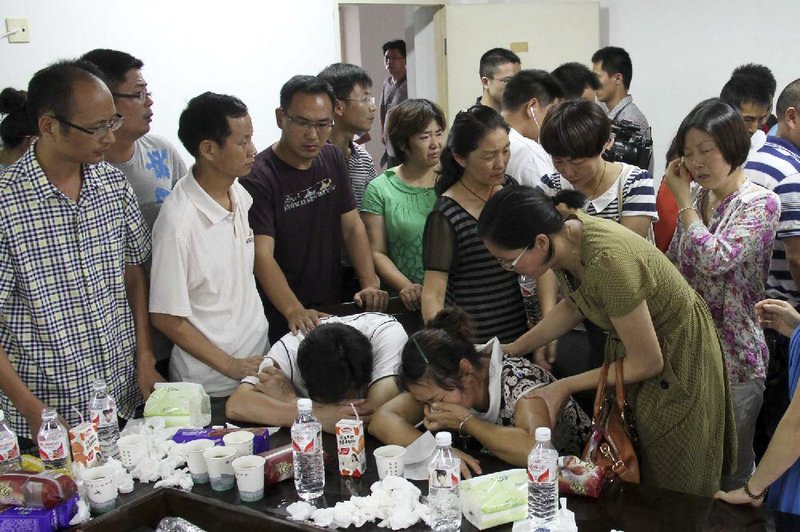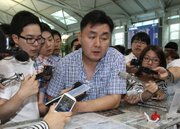The investigation into the crash of a passenger plane landing in San Francisco came to focus more sharply on possible pilot error Sunday as the South Korean airline ruled out a mechanical failure and federal investigators sought to interview the cockpit crew.
Two Chinese teenagers were killed and scores of other passengers were injured just before noon Saturday when the Boeing 777 airliner struck a sea wall at the end of the runway tail first and then skidded about 300 yards before catching fire.
Altogether, 305 of the 307 people aboard made it out alive in what survivors and rescuers described as nothing less than astonishing after a frightful scene of fire burning inside the fuselage, pieces of the aircraft scattered across the runway and people fleeing for their lives.
Asiana Airlines said the pilot in control of the Boeing 777 had little experience flying that type of plane and was landing one for the first time at San Francisco International Airport.
Asiana spokesman Lee Hyomin said today that Lee Gang-guk was trying to adjust to the 777. She said the pilot had nearly 10,000 hours flying other planes but had only 43 hours on the 777.
The chairman of the National Transportation Safety Board said Sunday that pilots of the Asiana Airlines jetliner that crashed a day earlier tried to abort the landing just seconds before the crash.
The safety board chairman, Deborah Hersman, said at a briefing that a crew member called for an increase in speed seven seconds before the plane clipped an embankment at the edge of the runway. She said the plane was traveling well below the target 157 mph needed to maintain a stable angle of approach. The jetliner’s cockpit recorder included the sounds of an automatic shaking of the throttle just before the crash, an indication that the plane was about to stall.
The plane slowed to as low as 124 miles per hour as it neared the runway, according to radar data compiled by FlightAware.com, a flight-tracking website.
Hersman’s comments came as investigators also began to examine whether an electronic landing aid that was out of service at the airport may have contributed to the crash of the jetliner. Hersman’s description of how the plane’s forward momentum slowed generally tracks other data showing the jetliner began to descend too fast because it did not have enough airspeed.
“We have talked with law enforcement officials who spoke with the pilots last night, and we hope to interview them soon,” Hersman said.
While the pilot should have recognized the abnormally strong descent, the safety board also said Sunday that it was investigating whether construction at the airport - which had temporarily shut down an electronic system, called a glide slope, that helps guide pilots to the proper landing slope - might have played a role in the crash.
Airlines had been told that the system was out of service, and many carriers, including Asiana, had been landing for weeks on that runway without difficulty, the official said. Air traffic control tapes indicate that the controller cleared the plane for a visual approach, meaning an approach for which the system was not necessary.
“Even if it was the least experienced crew in Asiana Airlines, the maneuver that led to this crash, on a difficulty scale of 1 to 10, this was a 2 or 3 at the most,” said Oscar Garcia, the chairman of Inter-Flight Global Corp., a consulting firm, who is licensed in the United States and Europe to fly the 777 and the 747, and who said he had flown the approach to that runway at San Francisco many times.
At least eight passengers remained in critical condition at two hospitals Sunday, officials said. Six of them were at San Francisco General Hospital, where the chief of trauma surgery said some of the 53 patients taken to the emergency room suffered from minor burns and injuries caused by seat belts or slamming into other seats. Those still in critical condition had head injuries, internal bleeding or fractured spines.
“We are used to these types of injuries, just not used to seeing them all at once,” said Margaret Knudson.
Hersman said the 7-yearold plane was equipped with current navigation tools to assist landing, including recent advances in GPS technology.
“A lot of this is not about the plane telling him, it’s about the pilot’s recognition of what’s going on … to be able to assess what’s happening and make the right inputs to make sure they’re in a safe situation,” Hersman said. “That’s what we expect from pilots. We want to understand what happened in this situation.”
The National Transportation Safety Board said the plane’s flight recorders had been recovered and were on their way to Washington for laboratory analysis.
In Seoul, where Flight 214 departed from for the trans-Pacific flight, the president of Asiana Airlines apologized Sunday for the crash.
“For now, we acknowledge that there were no problems caused by the 777-200 plane or engines,” Yoon Young-doo said at the company’s headquarters.
Chinese state media identified the two 16-year-olds who died in the crash as Ye Mengyuan and Wang Linjia, high school students from China’s eastern Zhejiang province. They were among a group of 70 students and teachers from three Chinese schools.
With the flight recorders from the Asiana airliner in hand and the pilots available, Bill English, the chief safety board investigator on the scene, has plenty to work with, but it probably will be months before his agency reaches a definitive conclusion.
Hersman underscored the methodical, cautious manner in which the safety board conducts its work in conversations with reporters Sunday.
“It’s a little bit early to be drawing conclusions. We really prefer to base statements on fact. Want to establish the facts and let the facts guide us in our work,” she said. “[National Transportation Safety Board] teams will be looking at aircraft operations, at human performance, survival factors, and we’ll be looking at the aircraft. We’ll be looking at power plants, systems and structures.”
INSIDE THE PLANE
When the plane hit the ground, oxygen masks dropped down, said Xu Da, a product manager at an Internet company in Hangzhou, China, who was sitting with his wife and teenage son near the back of the plane.
When he stood up, he said, he could see sparking - perhaps from exposed electrical wires.
He turned and could see the tail where the galley was torn away, leaving a gaping hole through which they could see the runway. Once on the tarmac, they watched the plane catch fire, and firefighters hose it down.
“I just feel lucky,” said Xu, whose family suffered some cuts and have neck and back pain.
In the chaotic moments after the landing, when baggage was tumbling from the overhead bins onto passengers and people all around her were screaming, Wen Zhang grabbed her 4-year-old son, who hit the seat in front of him and broke his leg.
Spotting a hole at the back of the jumbo jet where the bathroom had been, she carried her boy to safety.
“I had no time to be scared,” she said.
At the wreckage, police officers were throwing utility knives up to crew members inside the burning plane so they could cut away passengers’ seat belts. Passengers jumped down emergency slides, escaping from billowing smoke that rose high above the bay.
Nearby, people who escaped were dousing themselves with water from the bay, possibly to cool burn injuries, authorities said.
By the time the flames were out, much of the top of the fuselage had burned away. The tail section was gone, with pieces of it scattered across the beginning of the runway. One engine was gone, and the other was no longer on the wing.
Witnesses said that the plane’s tail struck the ground first and that the aircraft braked suddenly and spun around. They said the plane did not appear to catch fire until it came to a halt.
The plane’s tail snapped off on contact with the ground, suggesting that the pilot may have approached the runway with the plane’s nose higher in the air than normal.
The runway begins at the edge of San Francisco Bay, separated from the water by a stone sea wall. Debris from the plane was spread from the sea wall along the runway to the spot where the plane ended up.
The tail fin, the two small tail wings that had been joined to it and landing gear were strewn on the runway, closer to the sea wall than to the plane’s final location.
Pilots refer to a landing of this type as “coming down heavy.”
The Boeing 777 is considered a reliable aircraft with a good flight history. It was designed for long-range trips, including many trans-Atlantic and trans-Pacific flights.
Asiana configured its Boeing 777s to carry between 246 and 300 passengers.
The flight took off from Seoul just before 5 p.m. local time Friday for the trip across the Pacific.
There was no immediate indication as to what caused the crash, and experts were reluctant to speculate.
“These are experienced pilots, and they have flown airplanes lots of times,” said John Cox, an aviation safety consultant. “Why did they get it that slow and not take the corrective action? That is something the NTSB will certainly look at.”
Investigators are trying to determine whether one of the victims was killed by a firetruck rather than by crash trauma, San Francisco Fire Chief Joanne Hayes-White said, according to the San Francisco Chronicle.
“Based on the injuries sustained, it could have been one of our vehicles that added to the injuries, or another vehicle,” Hayes-White told the newspaper. “That could have been something that happened in the chaos.”
Asiana is Korea’s second-largest carrier after Korean Air. It has recently tried to expand its presence in the United States and joined the Star Alliance, which is anchored in the United States by United Airlines. Asiana has a fleet of 79 aircraft, including a dozen Boeing 777s.It flies to 23 countries and 71 cities.
According to Yonhap Television news in South Korea, six Ministry of Land, Infrastructure and Transport officials and 30 Asiana Airline officials are traveling to San Francisco. The airline is preparing another plane for passengers’ family members.
Information for this article was contributed by staff members of The New York Times; by staff members of The Associated Press; and by staff members of Bloomberg News.
Front Section, Pages 1 on 07/08/2013

